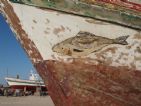
General part: Fishing in Djerba and Kerkenah
17/05/2012 10:46:21
Hi there from Sfax!!
Today we will give you some information about fishing and the sea that we have been gathering at Djerba and Kerkenah. We have not yet talked about the Kerkenah islands; we expect to describe them in the next few days.

Our driver at Djerba, Kamel, told us that nowadays nobody wants to do this job because it is too tough, and it is not give much money anymore. Those who used to do so are already too old, and their sons and grandsons do not follow. This activity was usual at Djerba, also in Kerlenah, and it is still done in the zone of Sfax.


The traditional pots were made out of pottery from Guellala, and were called “gargoulettes”. Later the shapes of the pots evolved, and nowadays they are even made out of concrete. This type of fishing is done in the same way in many other place, for instance in Castellón.
Fixed fisheries or “Zarbas” can be seen around specially in Djerba and Kerkenah. Theidea is to construct a path with palms so that the fish are forced to follow the path and enter romos called “achouchas”. There they put “drinas” where the fishes enter but they cannot exit anymore.


Best wishes!!































